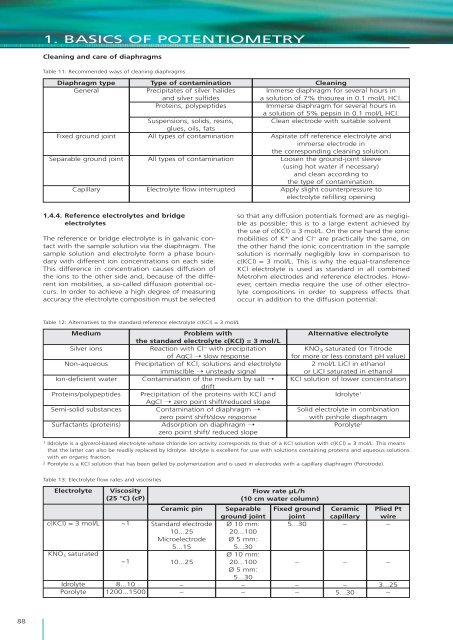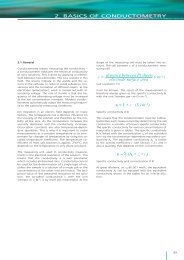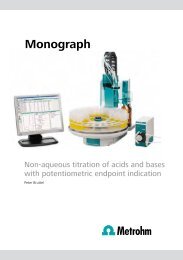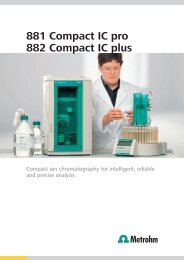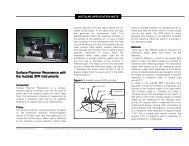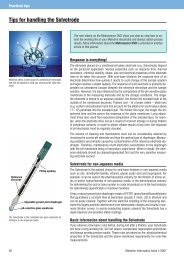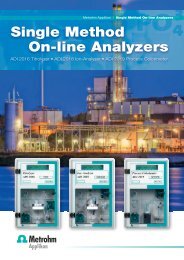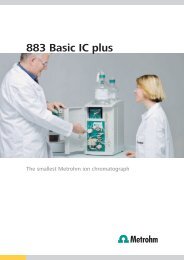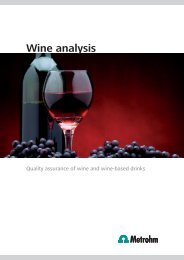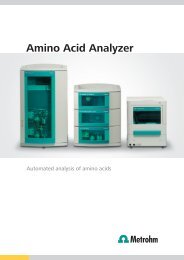What is the theoretical background of potentiometry? - Metrohm
What is the theoretical background of potentiometry? - Metrohm
What is the theoretical background of potentiometry? - Metrohm
You also want an ePaper? Increase the reach of your titles
YUMPU automatically turns print PDFs into web optimized ePapers that Google loves.
1. BASICS OF POTENTIOMETRYCleaning and care <strong>of</strong> diaphragmsTable 11: Recommended ways <strong>of</strong> cleaning diaphragmsDiaphragm typeGeneralFixed ground jointSeparable ground jointCapillaryType <strong>of</strong> contaminationPrecipitates <strong>of</strong> silver halidesand silver sulfidesProteins, polypeptidesSuspensions, solids, resins,glues, oils, fatsAll types <strong>of</strong> contaminationAll types <strong>of</strong> contaminationElectrolyte flow interruptedCleaningImmerse diaphragm for several hours ina solution <strong>of</strong> 7% thiourea in 0.1 mol/L HCl.Immerse diaphragm for several hours ina solution <strong>of</strong> 5% pepsin in 0.1 mol/L HCl.Clean electrode with suitable solventAspirate <strong>of</strong>f reference electrolyte andimmerse electrode in<strong>the</strong> corresponding cleaning solution.Loosen <strong>the</strong> ground-joint sleeve(using hot water if necessary)and clean according to<strong>the</strong> type <strong>of</strong> contamination.Apply slight counterpressure toelectrolyte refilling opening1.4.4. Reference electrolytes and bridgeelectrolytesThe reference or bridge electrolyte <strong>is</strong> in galvanic contactwith <strong>the</strong> sample solution via <strong>the</strong> diaphragm. Thesample solution and electrolyte form a phase boundarywith different ion concentrations on each side.Th<strong>is</strong> difference in concentration causes diffusion <strong>of</strong><strong>the</strong> ions to <strong>the</strong> o<strong>the</strong>r side and, because <strong>of</strong> <strong>the</strong> differention mobilities, a so-called diffusion potential occurs.In order to achieve a high degree <strong>of</strong> measuringaccuracy <strong>the</strong> electrolyte composition must be selectedso that any diffusion potentials formed are as negligibleas possible; th<strong>is</strong> <strong>is</strong> to a large extent achieved by<strong>the</strong> use <strong>of</strong> c(KCl) = 3 mol/L. On <strong>the</strong> one hand <strong>the</strong> ionicmobilities <strong>of</strong> K + and Cl – are practically <strong>the</strong> same, on<strong>the</strong> o<strong>the</strong>r hand <strong>the</strong> ionic concentration in <strong>the</strong> samplesolution <strong>is</strong> normally negligibly low in compar<strong>is</strong>on toc(KCl) = 3 mol/L. Th<strong>is</strong> <strong>is</strong> why <strong>the</strong> equal-transferenceKCl electrolyte <strong>is</strong> used as standard in all combined<strong>Metrohm</strong> electrodes and reference electrodes. However,certain media require <strong>the</strong> use <strong>of</strong> o<strong>the</strong>r electrolytecompositions in order to suppress effects thatoccur in addition to <strong>the</strong> diffusion potential.Table 12: Alternatives to <strong>the</strong> standard reference electrolyte c(KCl) = 3 mol/LMediumSilver ionsNon-aqueousIon-deficient waterProteins/polypeptidesSemi-solid substancesSurfactants (proteins)Problem with<strong>the</strong> standard electrolyte c(KCl) = 3 mol/LReaction with Cl – with precipitation<strong>of</strong> AgCl ➝ slow responsePrecipitation <strong>of</strong> KCl, solutions and electrolyteimm<strong>is</strong>cible ➝ unsteady signalContamination <strong>of</strong> <strong>the</strong> medium by salt ➝driftPrecipitation <strong>of</strong> <strong>the</strong> proteins with KCl andAgCl ➝ zero point shift/reduced slopeContamination <strong>of</strong> diaphragm ➝zero point shift/slow responseAdsorption on diaphragm ➝zero point shift/ reduced slopeAlternative electrolyteKNO 3 saturated (or Titrodefor more or less constant pH value)2 mol/L LiCl in ethanolor LiCl saturated in ethanolKCl solution <strong>of</strong> lower concentrationIdrolyte 1Solid electrolyte in combinationwith pinhole diaphragmPorolyte 21 IIdrolyte <strong>is</strong> a glycerol-based electrolyte whose chloride ion activity corresponds to that <strong>of</strong> a KCl solution with c(KCl) = 3 mol/L. Th<strong>is</strong> meansthat <strong>the</strong> latter can also be readily replaced by Idrolyte. Idrolyte <strong>is</strong> excellent for use with solutions containing proteins and aqueous solutionswith an organic fraction.2 Porolyte <strong>is</strong> a KCl solution that has been gelled by polymerization and <strong>is</strong> used in electrodes with a capillary diaphragm (Porotrode).Table 13: Electrolyte flow rates and v<strong>is</strong>cositiesElectrolyteV<strong>is</strong>cosity(25 °C) (cP)Fiow rate μL/h(10 cm water column)c(KCl) = 3 mol/LKNO 3 saturatedIdrolytePorolyte~1~18...101200...1500Ceramic pinStandard electrode10...25Microelectrode5...1510...25––Separableground jointØ 10 mm:20...100Ø 5 mm:5...30Ø 10 mm:20...100Ø 5 mm:5...30––Fixed groundjoint5...30–––Ceramiccapillary–––5...30Plied Ptwire––3...25–88


